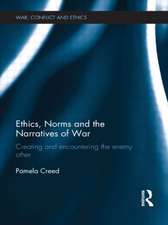Secrecy and Science: A Historical Sociology of Biological and Chemical Warfare
Autor Brian Balmeren Limba Engleză Paperback – 28 noi 2016
| Toate formatele și edițiile | Preț | Express |
|---|---|---|
| Paperback (1) | 461.66 lei 6-8 săpt. | |
| Taylor & Francis – 28 noi 2016 | 461.66 lei 6-8 săpt. | |
| Hardback (1) | 1054.71 lei 6-8 săpt. | |
| ASHGATE PUBLISHING – 28 apr 2012 | 1054.71 lei 6-8 săpt. |
Preț: 461.66 lei
Nou
Puncte Express: 692
Preț estimativ în valută:
88.34€ • 96.26$ • 74.44£
88.34€ • 96.26$ • 74.44£
Carte tipărită la comandă
Livrare economică 23 aprilie-07 mai
Preluare comenzi: 021 569.72.76
Specificații
ISBN-13: 9781138277281
ISBN-10: 1138277282
Pagini: 182
Dimensiuni: 156 x 234 mm
Greutate: 0.27 kg
Ediția:1
Editura: Taylor & Francis
Colecția Routledge
Locul publicării:Oxford, United Kingdom
ISBN-10: 1138277282
Pagini: 182
Dimensiuni: 156 x 234 mm
Greutate: 0.27 kg
Ediția:1
Editura: Taylor & Francis
Colecția Routledge
Locul publicării:Oxford, United Kingdom
Notă biografică
Brian Balmer, Reader in Science Policy Studies, University College London, UK
Recenzii
'’Secret science’ is much more than normal science with access restrictions applied; a world neatly divided into an inside and an outside. Brian Balmer uses various metaphors, including concentric spheres, labyrinths and archipelagos, to illuminate and explain a world with few absolutes... As the author explains in the preface, this book operates on two levels: it is a history of biological and chemical weapons research in the UK during the Cold War, and can be read as such. But it will also appeal to a smaller group, with an interest in science and technology studies, by illuminating the social processes by which science and secrecy are co-produced. I believe that the book’s insights and conclusions are much more broadly applicable even than this and will certainly interest an Australian readership. Although it sometimes uses technical language, with which a social scientist might feel more comfortable, this book is very accessible. It provides an intriguing perspective on the production of scientific knowledge, and the complications introduced by secrecy. The phrase ’social science’ now seems tautological to me: since scientific knowledge is socially-produced, how could the two ever be separated?' Australian Defence Force Journal
Cuprins
List of Abbreviations; Preface and Acknowledgements; Chapter 1 Secret Science; Chapter 2 Secrecy at Work: Scientists’ Defence of Biological Warfare Research; Chapter 3 Making Secrets: Accidents, Experiments and the Production of Knowledge; Chapter 4 Keeping, Disclosing and Breaching Secrets: Classification and Security; Chapter 5 Secrecy, Doubt and Uncertainty: Power/Ignorance?; Chapter 6 Secrecy, Transparency and Public Relations: Opening Up Porton Down in the ‘Year of the Barricades’; Chapter 7 Secret Spaces of Science: A Secret Formula, a Rogue Patent and Public Knowledge about Nerve Gas; Chapter 8 Opaque Science;
Descriere
Drawing on classical sociological writing on secrecy by Simmel, Merton and Shils Secrecy and Science draws on recently declassified documents to investigate significant episodes in the history of biological and chemical warfare. At the same time, it draws on more contemporary perspectives in science and technology studies that understand knowledge and social order as co-produced within heterogeneous networks of 'things and people' in order to develop a theoretical set of arguments about how the relationship between secrecy and science might be understood.









